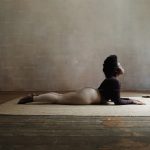How often have you walked into a studio, grabbed a mat, and settled down to the floor, preparing for the next hour (or so) of time just for you? You may have your own mat, or maybe more than one, rolled up in your yoga corner. Choosing a mat these days can — like most consumerist actions — be an overwhelming and confusing decision, with more than a few choices out there.
You can go for colourful prints, eco-mats, hand-designed mats, designer mats and more. If you’re a hot yoga fanatic then excellent grip might be at the top of your list of mat requirements. If you’re practicing every day, something with durability might be your most essential need. If you travel a lot with your job then something easy to carry around is going to be important to you.
Whatever your needs are, our yoga mats matter to us. We rack up countless hours on our mats, sweating, relaxing, meditating (maybe even crying). Our mats become symbols of relaxation, of challenge, of peace. Placing our mat down in the studio and taking a seat is often the our way of telling ourselves, the next 90 minutes are yours.
Deciding to buy a new mat, or maybe even your first, can be daunting. Where on earth do you begin? Have you ever stopped to consider (1) why you need a mat or (2) just where the yoga mat came from?
Yoga Mat Origins
The answer to the first question may seem obvious. Anyone who’s tried to practice without a mat will know it’s tough. Towels just don’t quite cut it as a DIY replacement, and carpets, or worse, hard floors, are not kind to anyone trying to maintain a stable Downward Dog. However, we can be pretty sure that the ancient yogis didn’t have the dilemma of buying eco-friendly vs affordable, multi-coloured print vs standard blue or purple. Around 5000 years ago, these issues simply weren’t issues.
Yogis in India would often practise their asana on tiger or deer skin, but these didn’t come cheap, so if one didn’t have the money for tiger or deer skin then practicing on grass was next best thing. However, anyone who’s taken a look out of the window recently might realise that this isn’t not always an option in our not-always-so-sunny England.
Not long after the introduction of yoga in the West came the development of the yoga mat. After realising that towels and even cotton mats just weren’t quite cutting it, rubber mats were introduced. We can thank senior Iyengar teacher Angela Famer for this. Angela, one of Iyengar’s most senior students, used to have problems gripping her hands and feet to the floor. After experimenting with a few different options — blankets, mattresses and even spitting on her own feet — she discovered that carpet underlay seemed to work best.
Apparently Iyengar was not impressed when he first saw her practicing on carpet underlay but years later she saw him giving a demonstration on one of her own mats. Just goes to show that you are best expert on your own body, not your teacher, no matter how great.
Mats For The Masses
Angela’s father, Richard Farmer saw a business opportunity, and became the first retailer of sticky mats. Produced in Europe, these mats were expensive by the time they reached the US, and so in 1990, Sara Chambers founded a company called Hugger Mugger, and developed a sturdy and sticky yoga mat. The rest, as they say is history.
Now we can get yoga mats in different lengths, widths and thickness, or yoga mats to help you align your feet and hands, with blocks, bricks, belts and more to match. You don’t have to get too obsessed about which mat you choose – let’s remember that your practice is about going inward, not about gazing at your mat with a certain amount of smugness – but enjoying the variety out there can be one of those secret pleasures that your non-yogi friends don’t quite get.
It’s worth mentioning here that some people think that practicing without a sticky mat can be a good way to work on building strength. For example, standing poses require more effort without a mat to prevent the feet from slipping, and can increase the sensation of the skin moving beneath the feet. Some people even argue that the increase of stickiness on mats is only encouraging the over-emphasis on flexibility vs strength.
Where Do You Down Dog?
At the end of the day, practice in a way that makes you feel safe, steady and relaxed. You may feel that you want to try a relatively stable pose without a mat, like Triangle, just to see the difference. Like most things in life, even exploring our attachment and need for a yoga mat can be a great to discover a little bit more about our own true nature — even if we think we’re just trying to find a way to stop sliding around in Down Dog.












